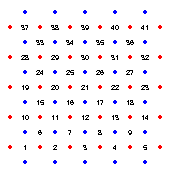 Bridge
Bridge Bridge
Bridge


You can change size of a game field by changing assignment N=5 in line 1 to something else. Be careful when you do this: line one has just one spare symbol left and it will start truncating symbols from the end of the line if enter too much characters.
00. П→x4 64 01. + 10 02. x→П9 49 03. В↑ 0e 04. КП→x9 d9 05. - 11 06. С/П 50 07. БП 51 08. 00 00(The last 2 byte command, БП 00, is not really necessary and added for convenience).
Then initialize registers to
7 x→П0 x→Пd (also x→Пe for МК-61, МК-52) 10 x→Пb 11 x→П4 12 x→Пc 15 x→П1 x→П2 x→П3 x→Па
 The game is played on a field shown in the picture. Possible moves are marked
with numbers from 1 to 41.
To start game player enters Сx В/О С/П and calculator makes first move
(always 1, connecting blue dots). Player then makes his move
connecting red dots and enters
the number crossed by the line as n С/П, calculator responds, etc.
Program does not detect if rules are violated and does not detect end game --
this is left to the player.
The game is played on a field shown in the picture. Possible moves are marked
with numbers from 1 to 41.
To start game player enters Сx В/О С/П and calculator makes first move
(always 1, connecting blue dots). Player then makes his move
connecting red dots and enters
the number crossed by the line as n С/П, calculator responds, etc.
Program does not detect if rules are violated and does not detect end game --
this is left to the player.
I do not know who is the author of this program or where it was published first. BLK showed me this program and he says he learned about it circa 1984-1985. I do not have original copy of the program, so I had to restore it from memory, so constants and register addresses may differ from the original. I will be grateful for information about exact form of the original program, as well as for information where it was first published.